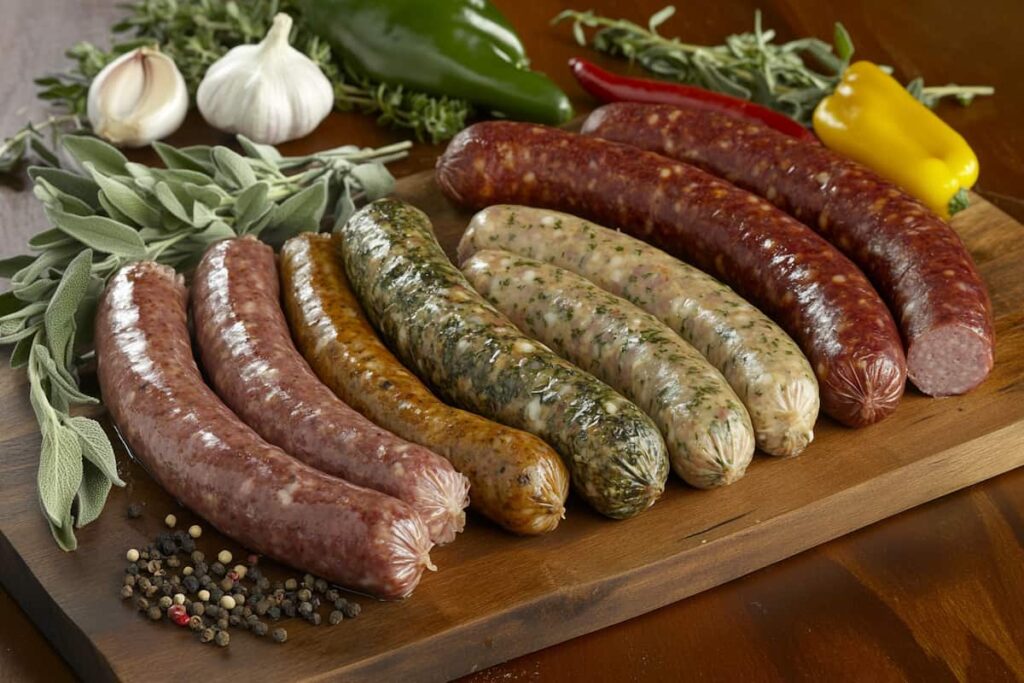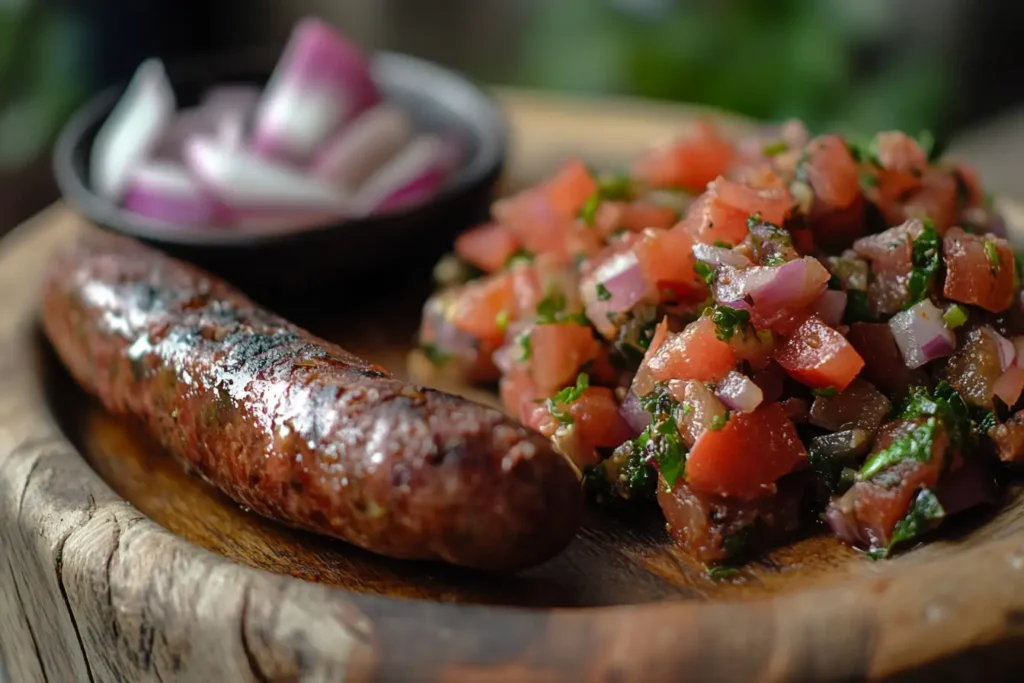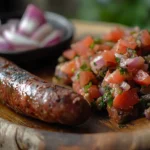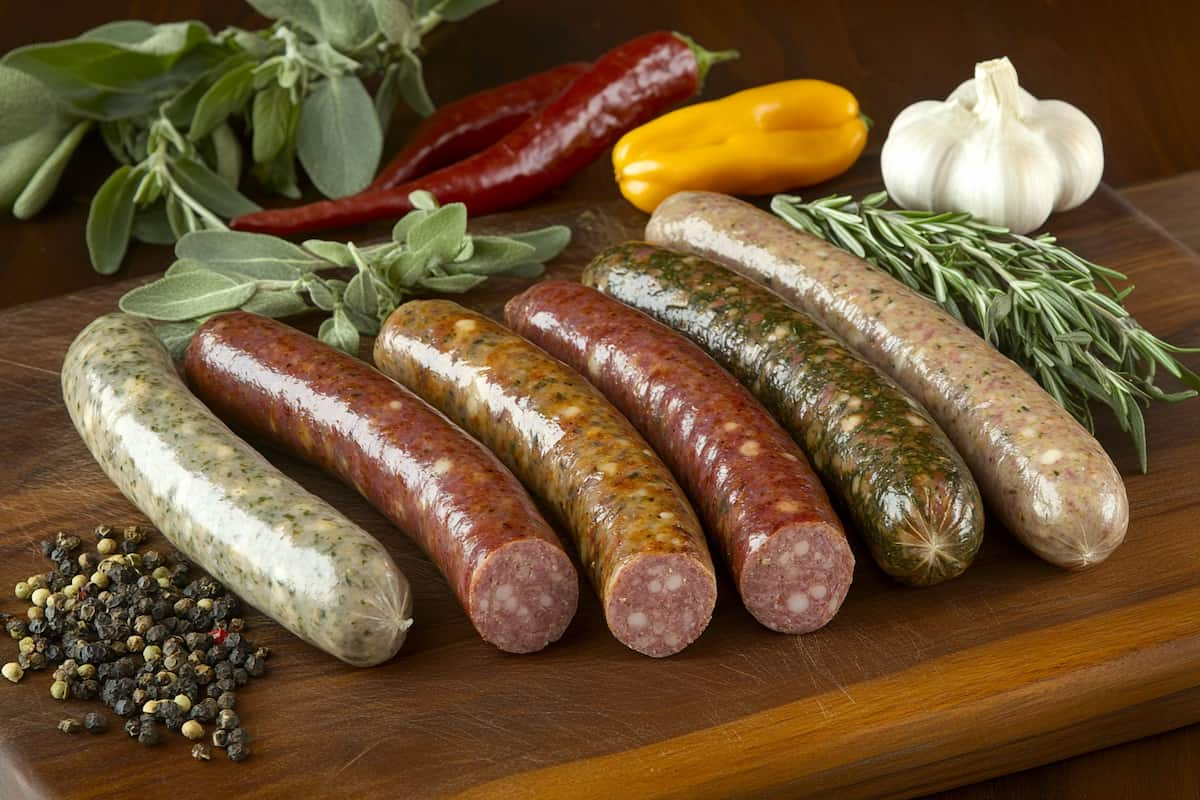Many people wonder what makes breakfast sausage unique compared to other varieties. This favorite in American homes features a distinct taste and specific ingredients that set it apart. Understanding the differences is key, as this type is characterized by a special spice mix and particular meat preparation. While other sausages may be more heavily seasoned for general cooking, breakfast options are crafted with a lighter, sweeter flavor profile that perfectly complements morning meals.
Key Takeaways
- Breakfast sausage has a distinct flavor profile compared to regular sausage
- Sausage types vary in ingredients and spice blends
- Breakfast sausage is a popular choice for morning meals
- Understanding the differences between sausage types can help with menu planning
- Breakfast sausage is a staple in many American households
Introduction to Sausage Types
Sausages are a big part of many cuisines, and there are many types to try. To distinguish between breakfast and regular sausage, we must consider what makes them special. Breakfast sausage, for example, is made with meats, seasonings, and ingredients like sage and black pepper.
There are many types of sausage, each with its own ingredients, flavors, and methods of making. You might find breakfast sausage, Italian sausage, and Chorizo, among others. Each has its own taste and texture, perfect for different dishes and cooking styles.

The choice of breakfast sausage ingredients is key to its flavor and quality. Using top-notch breakfast sausage ingredients can really make a dish stand out. It’s a big reason why breakfast sausage is so popular in the morning.
Definition
Breakfast sausage is a mix of pork, seasonings, and spices. It’s often served with breakfast foods like eggs, pancakes, and toast.
Definition of regular sausage
Regular sausage, by contrast, can be made from many different meats and ingredients. It’s great as a snack or in various dishes.
Historical background
Sausage has a long history, dating back to ancient times. Places like Egypt and Greece were known for making sausages. Over time, different cultures have created their own sausage types and ways of making them.
The Main Differences Between Breakfast and Regular Sausage
There are two main types of sausage: breakfast sausage and regular sausage. Each has its own breakfast sausage characteristics and regular sausage characteristics. The main difference is in texture. It is denser and coarser, while regular sausage is finer.
The flavor of breakfast sausage characteristics is often stronger and more savory. On the other hand, regular sausage characteristics can vary more. Here are some key differences:
- Ingredients: Breakfast sausage has more spices and herbs. Regular sausage has a wider variety of ingredients.
- Flavor profile: Breakfast sausage is smokier and more savory. Regular sausage is sweeter and spicier.

Choosing between breakfast sausage and regular sausage depends on your taste. Knowing the characteristics of each helps you pick the best sausage for you.
Key Ingredients
The ingredients of breakfast sausage greatly affect its taste and texture. The sausage’s ingredients usually include meats, spices, and seasonings, and the special spice blend varies by sausage type.
A quality breakfast sausage combines meat composition like pork and beef. The fat content ratio keeps it moist and tasty. Common ingredients include salt, pepper, sage, and black pepper.
There are many sausage cooking methods. Some like pan-frying, while others prefer grilling or baking. The method changes the sausage’s flavor and texture.
| Ingredient | Percentage |
|---|---|
| Pork | 70% |
| Beef | 20% |
| Spices | 10% |
Knowing the ingredients and sausage cooking methods helps you choose the right sausage. Whether you prefer classic pork or something unique, there’s a sausage for everyone.
Regular Sausage Characteristics
Regular sausage comes in many forms, depending on its type and ingredients. It often has a finer texture and a more delicate taste. These traits come from the meat, seasonings, and how it’s made.
When it comes to sausage storage, regular sausage is quite flexible. It can be used in many dishes, like sandwiches or salads. Keeping it fresh is key. Here are some important tips:
- Store regular sausage in a cool, dry place to prevent moisture from accumulating.
- Keep regular sausage away from direct sunlight and heat sources.
- Use airtight containers or wrapping to prevent air from reaching the sausage.
By following these tips, you can keep your regular sausage fresh and tasty. Proper sausage storage helps preserve its texture and flavor.
Regular sausage is versatile and loved in many dishes. With the right storage, you can enjoy it for longer.
Knowing how to store regular sausage can enhance your cooking and make this versatile ingredient even more useful.
Seasoning Profiles That Set Them Apart
The special mix of sausage seasoning makes breakfast sausage taste unique. Traditional seasonings include salt, pepper, and sage, key ingredients that boost the sausage’s flavor and texture.
Regular sausage, on the other hand, has varied seasoning profiles. Spices like paprika, garlic, and onion powder are common. These give the sausage a deep, savory taste, which many love.
Seasoning is vital for breakfast sausage’s flavor and texture. The right mix can turn a simple sausage into a delicious breakfast treat. Some top ingredients are:
- Sage
- Thyme
- Black pepper
- Brown sugar
Knowing about different seasoning profiles helps you create tasty sausage recipes. Whether you like traditional or regular breakfast sausage, the secret to great taste is in the seasoning and ingredients.
Size and Shape Variations
Sausage types come in many sizes and shapes. In the United States, it is often found as links or patties. Regular sausage, on the other hand, can be coils or pinwheels.
Here are some popular sausage types and their usual shapes:
- Breakfast sausage: links, patties
- Italian sausage: coils, links
- Chorizo: links, slices
When picking a sausage, consider how you’ll cook it. Different shapes and sizes can affect cooking time and taste. For instance, thinner sausages cook quicker than thicker ones.
Knowing about different sausages can help you choose better. Whether you like breakfast sausage or regular sausage, there’s something for everyone.
| Sausage Type | Typical Shape | Cooking Method |
|---|---|---|
| Breakfast Sausage | Links, Patties | Pan-frying, Grilling |
| Italian Sausage | Coils, Links | Grilling, Roasting |
| Chorizo | Links, Slices | Grilling, Pan-frying |
Cooking Methods and Preparation
Cooking sausage can really change its taste and texture. For breakfast sausage, cook it over medium-high heat, which makes it brown and crispy. Always use a thermometer to check the temperature, aiming for 160°F. This is key for staying safe with its ingredients.
There are many ways to cook sausage, such as grilling, pan-frying, or baking. Each method has its own advantages and disadvantages. Grilling adds a smoky taste, while pan-frying makes it crispy. Baking is great for cooking sausage without extra oil.
Best Practices for Cooking Sausage
- Cook sausage over medium-high heat to achieve a nice brown color and crispy texture
- Use a thermometer to ensure the internal temperature reaches 160°F
- Choose a cooking method that suits your personal preference, such as grilling, pan-frying, or baking
You can make tasty and safe sausage dishes by following these tips and choosing the right sausage methods. Whether it’s breakfast sausage ingredients or regular sausage, try different ways to find your favorite.
Regional Variations Across America
America is home to various sausages, each with its own flavor. Every region has its own special sausage, from the spicy sausages of the South to the hearty ones of the North. The ingredients, cooking methods, and taste of sausages vary greatly, making them a fascinating topic.
Some notable regional sausages include:
- Andouille sausage from Louisiana is known for its smoky flavor and spicy kick
- Knockwurst from the Northeast, a short and plump sausage with a garlicky flavor
- Chorizo from the Southwest, a spicy sausage with a Spanish influence

These sausages reflect the local ingredients and traditions of each area. For instance, using paprika in Southern sausage shows the region’s Hungarian roots. The variety of sausages across America makes them exciting to explore.
Regional sausage variations go beyond the type of meat used. They also involve how the meat is prepared and cooked. Each region has its own way of making sausage, from traditional methods to modern twists.
In conclusion, the different sausages across America show the country’s diverse culinary scene. Exploring these variations allows us to appreciate the rich history and cultural heritage of sausage in America.
| Region | Sausage Type | Notable Ingredients |
|---|---|---|
| South | Andouille | Pork, garlic, paprika |
| Northeast | Knockwurst | Beef, garlic, coriander |
| Southwest | Chorizo | Pork, chili peppers, garlic |
Nutritional Comparison
Breakfast sausage and regular sausage have different nutritional values. The calorie count varies based on the ingredients and cooking methods. It has 200 to 500 calories per serving, while regular sausage can have 300 to 600 calories.
It usually has 10-15 grams of protein per serving, while regular sausage can have up to 20-25 grams. However, it has more saturated fat than regular sausage, and some brands use leaner meats and spices to lower their fat content.
A nutritional comparison of sausage can be summarized in the following table:
| Type of Sausage | Calorie Content | Protein Values | Fat Content |
|---|---|---|---|
| Breakfast Sausage | 200-500 calories | 10-15 grams | 10-20 grams |
| Regular Sausage | 300-600 calories | 20-25 grams | 15-30 grams |
The nutritional content of sausage depends on ingredients and cooking methods. Choosing sausages with leaner meats and spices helps make better choices. Consumers can be more informed about their sausage nutrition and ingredients.
Best Uses and Serving Suggestions
Sausage is a versatile ingredient for many dishes, from breakfast to dinner. It’s great with eggs, pancakes, or waffles, making it a favorite for many.
The right mix of ingredients is key to making breakfast sausage. Common ones include pork, sage, and black pepper. These help make tasty dishes like omelets, burritos, and sandwiches.
Breakfast Combinations
- Sausage and egg skillet
- Sausage and pancake stack
- Sausage and waffle sandwich
Check out our post on Banana Waffles: How to Make Them Perfect Every Time
Sausage is also great in main dishes. It works well in sandwiches, salads, or on baked potatoes. The sausage uses are endless, inviting creativity in the kitchen.
Main Dish Applications
- Sausage and pepper sandwiches
- Sausage and potato salad
- Sausage and cheese baked potatoes
Exploring different ingredients and sausage uses leads to many tasty dishes. These can satisfy even the most discerning palates.
Storage and Shelf Life Differences
Regarding sausage storage, the type of sausage matters a lot. It is more perishable and needs careful handling. On the other hand, regular sausage can last longer, making it great for stocking up.
To store sausage properly, keep it in the fridge at a temperature below 40°F (4°C). This prevents the growth of bacteria and other harmful substances. Also, airtight containers or wrapping should be used to keep moisture and contaminants out.
- Keep sausage away from strong-smelling foods, as it can absorb odors easily
- Use a meat thermometer to ensure the sausage is cooked to a safe internal temperature
- Freeze sausage for longer-term storage, but make sure to label and date it properly
Follow these tips and learn about the characteristics of the meal to enjoy it. Proper sausage storage is key to keeping it fresh and safe to eat.
Conclusion: Making the Right Sausage Choice
The choice between breakfast and regular sausage depends on taste and needs. Knowing the differences between each type helps cooks make better choices, which leads to delicious meals.
Breakfast sausage is known for its bold flavors, while regular sausage offers a more savory taste. There’s a wide range of sausages to try. With the right choice, any meal can become special. So, start exploring and find your favorite sausage.
Frequently Asked Questions
What makes morning sausage different from regular sausage?
It is unique because it is packed tightly and has a coarser texture. Regular sausage is finer and comes in many flavors
What are the key ingredients in morning sausage?
It contains a special spice blend, certain meats, and a fat ratio, creating a distinct taste and texture.
What are the common characteristics of regular sausage?
Regular sausage is finer and has a lighter flavor. It’s also more versatile, used in sandwiches and salads.
Print
Chorizo Sausage
- Total Time: 25 minutes
- Yield: 4 Servings 1x
- Diet: Gluten Free
Description
Chorizo sausage is a flavorful, spicy sausage from Spain and Mexico. Made from ground pork and seasoned with smoked paprika, garlic, and chili, it delivers a smoky, bold taste. It is perfect for grilling, frying, or crumbling into dishes like stews, tacos, or breakfast scrambles.
Ingredients
- 1 pound ground pork (or a mix of pork and beef)
- 2 tablespoons smoked paprika (sweet or hot)
- 1 teaspoon chili powder
- 1 teaspoon ground cumin
- 1 teaspoon dried oregano
- 1 teaspoon salt
- 1/2 teaspoon black pepper
- 3 garlic cloves, minced
- 1 tablespoon red wine vinegar (optional, for tang)
- 1/2 teaspoon cayenne pepper (optional, for extra heat)
Instructions
- Prepare the Spice Blend: In a small bowl, mix smoked paprika, chili powder, cumin, oregano, salt, black pepper, and cayenne pepper.
- Combine with Meat: Add the ground pork and garlic in a large bowl. Sprinkle the spice blend over the meat and mix thoroughly with your hands. Add red wine vinegar for a tangy kick.
- Shape or Store: Form the mixture into patties or sausage shapes, or leave it loose for crumbles.
- Cook: Heat a skillet over medium heat. Cook patties or crumbles for 3-4 minutes per side until browned and cooked, or grill sausages until the internal temperature reaches 160°F (71°C).
- Serve: Use in tacos, paellas, or alongside eggs and potatoes for a hearty meal.
Notes
- For a smokier flavor, use hot smoked paprika.
- Chorizo can be frozen raw for up to 3 months.
- Mexican-style chorizo is typically uncooked, while Spanish chorizo is often cured or smoked. Adjust the recipe to your preference.
- Prep Time: 15 minutes
- Cook Time: 10 minutes
- Category: Main Course
- Method: Grilling or Pan-frying
- Cuisine: Spanish, Mexican
Nutrition
- Serving Size: 1 sausage (approx. 4 oz)
- Calories: 260
- Sugar: 1g
- Sodium: 500mg
- Fat: 22g
- Saturated Fat: 8g
- Unsaturated Fat: 14g
- Trans Fat: 0g
- Carbohydrates: 1g
- Fiber: 0g
- Protein: 16g
- Cholesterol: 65mg



